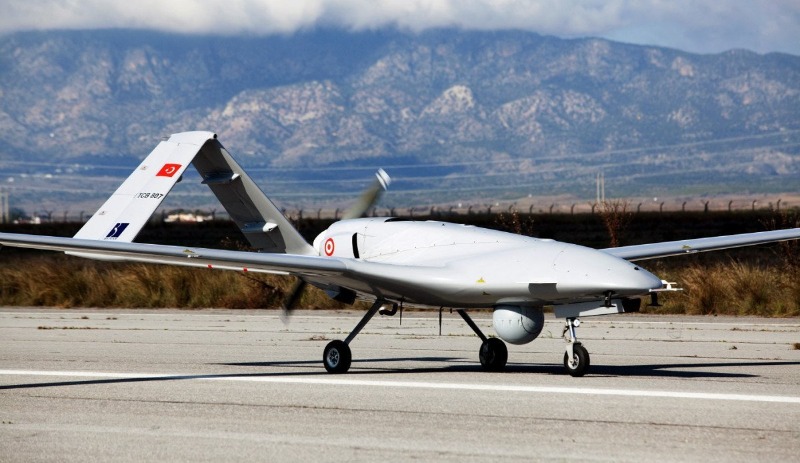Recent comments from top Iranian officials strongly suggest that Tehran perceives itself as a rapidly ascending arms exporter, especially of drones. In reality, Iran, at least under the incumbent regime in Tehran, will not likely prove capable of replicating Turkey’s impressive success in exporting its well-known homegrown Bayraktar TB2 drone to numerous countries worldwide in just a few short years. Iran will have to settle for a much more limited market consisting of other pariah states and cash-strapped countries with little to no viable alternatives.
In a televised address on Oct. 22, Iranian President Ebrahim Raisi claimed that foreign leaders frequently inquire about Iran’s indigenous military equipment when he travels abroad.
“Until recently, our military industry did not even have barbed wire, and they would not give it to us,” he said. “Today, in New York, in Samarkand, when I meet with heads of state, they ask me: ‘You don’t want to sell us the products of your military industries?'”
Raisi claimed he would respond to such questions by asking why those countries want Iranian hardware all of a sudden, to which they invariably reply: “Your industry is more advanced. It is different from the rest of the world.”

On Aug. 22, the aerospace commander of Iran’s powerful Islamic Revolutionary Guard Corps (IRGC) paramilitary also used the barbed wire analogy to illustrate how far Iran’s arms industry has come.
“In the military field, we did not have the capabilities that we have now,” said Brigadier General Amir Ali Hajizadeh. “In the past, we used to import even barbed wire, but now we export drones.”
And on Oct. 18, Iranian Major General Yahya Rahim Safavi emphasized Iran’s success in drone manufacturing.
“Today we have reached a point that 22 world countries are demanding to purchase unmanned aircraft from Iran,” he said.
These 22 countries include Armenia, Algeria, Serbia, Tajikistan and Venezuela, although analysts are skeptical about the alleged interest from Serbia.
With Iranian-built Shahed-136 loitering munitions (so-called suicide drones) descending on Ukrainian cities almost every day, it’s an indisputable fact that Iran has successfully exported a very large number of its drones to Russia.

Despite this, Tehran officially denies the very existence of what could be – with the addition of an expected Russian acquisition of hundreds of Iranian ballistic missiles – its most significant arms export ever. Iranian Foreign Minister Hossein Amirabdollahian even went so far as to say that Tehran “should not remain indifferent” if it is “proven to us that Iranian drones are being used in the Ukraine war against people.”
It suits Russia to support this self-evident falsehood. Moscow officially maintains that it only uses Russian hardware with “Russian names” in Ukraine. “We do not have such information,” said Russian presidential spokesperson Dmitry Peskov when asked about Russia’s widely publicized acquisition of Iranian drones.
Iranian drones in Russian service do indeed have Russian names. The Shahed-136, for example, has been rebranded the Geran-2. The Houthis in Yemen also rebrand their Iranian-designed drones to cloak their otherwise obvious origin. For example, the Houthi versions of the Ababi-2 are known as the Qasef-1 and Qasef-2K, respectively.

Even if Iran was open about its sale of drones to Russia, that deal certainly isn’t indicative of an ascending Iranian drone industry that could rival that of Turkey or China.
Moscow reportedly wanted a factory to build TB2s. There were also indicators an entire year before this war that it was fearful of these Turkish drones given their prior combat successes in Syria, Libya, and Nagorno-Karabakh in 2020. Turkey refuses to sell Russia the TB2, and China isn’t willing to sell Russia its drones after the invasion since that would undoubtedly incur strong U.S. sanctions. These factors make it clear that Russia had nowhere else to turn other than Iran for large quantities of cheap drones to substitute and supplement its dwindling missile stockpiles.
That is, of course, not to say that Iran hasn’t had export success elsewhere. Outside the Middle East, Ethiopia and Venezuela seem to have acquired Iran’s Mohajer-6 armed drone. Tehran also inaugurated a factory in Tajikistan for the local assembly of its Ababil-2 drone, the first of its kind to build Iranian drones abroad. We may soon learn that a similar factory has been established in Russia for mass-producing Shaheds.
Still, Turkish drones are much more prevalent in the Middle East, North Africa, Central Asia, Southeast Asia, and Eastern Europe and will likely remain so for the foreseeable future. Furthermore, Turkey is establishing factories for locally manufacturing its drones in Kazakhstan, Ukraine, and the United Arab Emirates.
The TB2 undoubtedly has a mixed reputation. Kurdish civilians terrorized by Turkish drone strikes in Iraq and Syria understandably have a much different view of them than Ukrainians — who effectively used their TB2s to halt Russia’s advance on Kyiv early in the war. Russia’s deployment of Iranian drones to terrorize Ukrainian civilians, on top of their prior use by militias in the Middle East, has given them a much more one-sided reputation as crude and indiscriminate terror weapons. That’s probably one reason Ukrainian President Volodymyr Zelensky chose one of the 300+ Shahed drones his forces have shot down in recent weeks to stand beside when he recently vowed Ukraine would “clip the wings” of Russia’s airpower to constrain Moscow’s ability to terrorize Ukrainian cities with Iran’s assistance.
Iran will most likely find a dozen or so countries interested in procuring its drones. Safavi was probably telling the truth when he said 22 countries are interested in Tehran’s drones. However, the majority of these countries have few other options for political or financial reasons. Therefore, the market for Iranian drones will most likely remain a relatively niche one that cannot realistically hope to attain the international success that Turkey’s drone industry presently enjoys.
By: Paul Iddon
Source: Forbes



